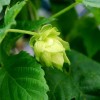 Hops are perennial, herbaceous climbing plants commonly cultivated for their strobiles or cones (Figure 1). The cones are often used for flavoring and aroma in food, tea, and beer (Burgess 1964). Hops can make a unique addition to a home garden or landscape. It grows rapidly in the early spring to late summer. Plants reach a mature height of 18–25 feet in one year and produce cones from mid-summer to early fall. This 2-page fact sheet was written by Brian J. Pearson, and published by the UF Department of Environmental Horticulture, October 2013.
Hops are perennial, herbaceous climbing plants commonly cultivated for their strobiles or cones (Figure 1). The cones are often used for flavoring and aroma in food, tea, and beer (Burgess 1964). Hops can make a unique addition to a home garden or landscape. It grows rapidly in the early spring to late summer. Plants reach a mature height of 18–25 feet in one year and produce cones from mid-summer to early fall. This 2-page fact sheet was written by Brian J. Pearson, and published by the UF Department of Environmental Horticulture, October 2013.
http://edis.ifas.ufl.edu/ep488
Tag: Environmental Horticulture Department
’Fairytale Princess’ and ’Red Hot’: Red Lance-leaved Caladium Cultivars
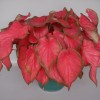 Caladiums are valued in landscapes and containers for their colorful and variable-shaped leaves. Two types of caladium cultivars exist in commercial production: fancy- and lance-leaved. ‘Florida Sweetheart’ is the most popular lance-leaved commercial cultivar of all colors. It produces wide lance leaves with a rosy color and relatively large tubers. ‘Florida Red Ruffles’ is the most popular red, lance-leaved commercial cultivar among caladium growers, greenhouse growers, and nurseries. It has excellent sunburn tolerance. Both cultivars were introduced by the University of Florida (UF) caladium breeding program. This 9-page fact sheet was written by Zhanao Deng, and published by the UF Department of Environmental Horticulture, August 2013.
Caladiums are valued in landscapes and containers for their colorful and variable-shaped leaves. Two types of caladium cultivars exist in commercial production: fancy- and lance-leaved. ‘Florida Sweetheart’ is the most popular lance-leaved commercial cultivar of all colors. It produces wide lance leaves with a rosy color and relatively large tubers. ‘Florida Red Ruffles’ is the most popular red, lance-leaved commercial cultivar among caladium growers, greenhouse growers, and nurseries. It has excellent sunburn tolerance. Both cultivars were introduced by the University of Florida (UF) caladium breeding program. This 9-page fact sheet was written by Zhanao Deng, and published by the UF Department of Environmental Horticulture, August 2013.
http://edis.ifas.ufl.edu/ep481
New Gerbera Daisy Varieties for Large Containers and Flower Gardens
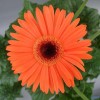 Gerbera daisy is one of the most popular flowers in the United States. Recently, interest has increased in growing gerberas in large containers for indoor or outdoor use. ‘Funtastic™ Tangerine Eye’ and ‘Funtastic™ Golden Eye’ have been selected and tested specifically for use in large containers. These cultivars produce large, powdery mildew-resistant plants and large, attractive flowers in orange-red or yellow-orange that complement the existing Funtastic™ series of gerbera cultivars. This 8-page fact sheet was written by Zhanao Deng, and published by the UF Department of Environmental Horticulture, September 2013.
Gerbera daisy is one of the most popular flowers in the United States. Recently, interest has increased in growing gerberas in large containers for indoor or outdoor use. ‘Funtastic™ Tangerine Eye’ and ‘Funtastic™ Golden Eye’ have been selected and tested specifically for use in large containers. These cultivars produce large, powdery mildew-resistant plants and large, attractive flowers in orange-red or yellow-orange that complement the existing Funtastic™ series of gerbera cultivars. This 8-page fact sheet was written by Zhanao Deng, and published by the UF Department of Environmental Horticulture, September 2013.
http://edis.ifas.ufl.edu/ep482
Phoenix canariensis: Canary Island Date Palm
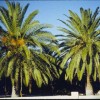 The Canary Island date palm is native to the Canary Islands. Although it can reach heights of 40–50 feet, it is slow growing and requires many years to attain that height. It has 8- to 15-foot-long rigid leaves that contain up to 200 V-shaped leaflets, the basal ones of which are modified into long, sharp spines. Leaves are not self-cleaning and must be manually removed when dead, but the leaf bases eventually rot off, leaving an attractive diamond-shaped pattern of leaf scars on the 2- to 3-foot-diameter trunk. On older specimens, the basal foot or so of the trunk typically is covered with short root initials. This 6-page fact sheet was written by T. K. Broschat, and published by the UF Department of Environmental Horticulture, August 2013.
The Canary Island date palm is native to the Canary Islands. Although it can reach heights of 40–50 feet, it is slow growing and requires many years to attain that height. It has 8- to 15-foot-long rigid leaves that contain up to 200 V-shaped leaflets, the basal ones of which are modified into long, sharp spines. Leaves are not self-cleaning and must be manually removed when dead, but the leaf bases eventually rot off, leaving an attractive diamond-shaped pattern of leaf scars on the 2- to 3-foot-diameter trunk. On older specimens, the basal foot or so of the trunk typically is covered with short root initials. This 6-page fact sheet was written by T. K. Broschat, and published by the UF Department of Environmental Horticulture, August 2013.
http://edis.ifas.ufl.edu/st439
Soil Characteristics and Management Practices for Urban Residential Landscapes
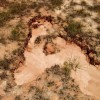 Newly constructed urban residential landscape soils sampled within Central Florida are dominated by large sand particles and possess low soil moisture retention. Therefore, irrigation and fertilizer applications should be managed to match site conditions and prevent overapplication of water and nutrient leaching. Sampled soils in newly developed urban residential communities were found to be highly compacted and likely to inhibit plant establishment and growth. This 3-page fact sheet was written by Brian J. Pearson, and published by the UF Department of Environmental Horticulture, July 2013.
Newly constructed urban residential landscape soils sampled within Central Florida are dominated by large sand particles and possess low soil moisture retention. Therefore, irrigation and fertilizer applications should be managed to match site conditions and prevent overapplication of water and nutrient leaching. Sampled soils in newly developed urban residential communities were found to be highly compacted and likely to inhibit plant establishment and growth. This 3-page fact sheet was written by Brian J. Pearson, and published by the UF Department of Environmental Horticulture, July 2013.
http://edis.ifas.ufl.edu/ep479
Armillaria Root Rot (Also known as Mushroom Root Rot, Shoestring Root Rot, Honey Mushroom Rot)
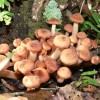 Armillaria root rot is a disease that decays the root system of many common trees and shrubs. It is caused by several species of Armillaria, fungi that can be recognized by the clusters of yellow to honey-colored mushrooms that emerge during moist conditions. The disease is often lethal, and infected trees may have wilting branches, branch dieback, and stunted growth. Infected trees and shrubs should be removed and replaced with resistant species. This 4-page fact sheet was written by Laura Sanagorski, Aaron Trulock, and Jason Smith, and published by the UF Department of Environmental Horticulture, July 2013.
Armillaria root rot is a disease that decays the root system of many common trees and shrubs. It is caused by several species of Armillaria, fungi that can be recognized by the clusters of yellow to honey-colored mushrooms that emerge during moist conditions. The disease is often lethal, and infected trees may have wilting branches, branch dieback, and stunted growth. Infected trees and shrubs should be removed and replaced with resistant species. This 4-page fact sheet was written by Laura Sanagorski, Aaron Trulock, and Jason Smith, and published by the UF Department of Environmental Horticulture, July 2013.
http://edis.ifas.ufl.edu/ep478
Weed Management Guide for Florida Lawns
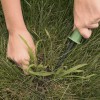 Weeds can be defined as unwanted plants or plants growing out of place. Proper identification and some understanding of how and why weeds are present in a lawn are important when selecting the best control strategy. Knowing whether or not weeds were previously present in a particular area also helps homeowners prepare control measures in the future. Weed control should be a carefully planned and coordinated program. This 8-page fact sheet was written by J.Bryan Unruh, Ramon G. Leon, Barry J. Brecke, and Laurie E. Trenholm, and published by the UF Department of Environmental Horticulture, July 2013.
Weeds can be defined as unwanted plants or plants growing out of place. Proper identification and some understanding of how and why weeds are present in a lawn are important when selecting the best control strategy. Knowing whether or not weeds were previously present in a particular area also helps homeowners prepare control measures in the future. Weed control should be a carefully planned and coordinated program. This 8-page fact sheet was written by J.Bryan Unruh, Ramon G. Leon, Barry J. Brecke, and Laurie E. Trenholm, and published by the UF Department of Environmental Horticulture, July 2013.
http://edis.ifas.ufl.edu/ep141
Florida Foliage House Plant Care: ZZ Plant
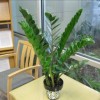 ZZ plant is enjoyed for its unique appearance, its ability to grow under low light conditions, and its tolerance to drought. ZZ’s naturally glossy leaves are so shiny that the plant appears to have been polished. This 2-page fact sheet was written by R. J. Henny and J. Chen, and published by the UF Department of Environmental Horticulture, July 2013.
ZZ plant is enjoyed for its unique appearance, its ability to grow under low light conditions, and its tolerance to drought. ZZ’s naturally glossy leaves are so shiny that the plant appears to have been polished. This 2-page fact sheet was written by R. J. Henny and J. Chen, and published by the UF Department of Environmental Horticulture, July 2013.
http://edis.ifas.ufl.edu/ep480
Florida Foliage House Plant Care: Spathiphyllum
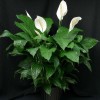 Most Spathiphyllum are seen in flower when at market. The attractive white blooms, called spathes, are long lasting. With proper plant care, Spathiphyllum may produce blooms year after year. Spathiphyllum is a very attractive house plant even when not in bloom and adapts well to home and patio environments. This 2-page fact sheet was written by R. J. Henny and J. Chen, and published by the UF Department of Environmental Horticulture, June 2013.
Most Spathiphyllum are seen in flower when at market. The attractive white blooms, called spathes, are long lasting. With proper plant care, Spathiphyllum may produce blooms year after year. Spathiphyllum is a very attractive house plant even when not in bloom and adapts well to home and patio environments. This 2-page fact sheet was written by R. J. Henny and J. Chen, and published by the UF Department of Environmental Horticulture, June 2013.
http://edis.ifas.ufl.edu/ep477
Alternatives to Invasive Plants Commonly Found in Central Florida Landscapes
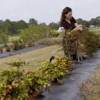 Based on years of UF/IFAS research producing and trialing cultivars, this 3-page fact sheet lists native and non-invasive, non-native ornamentals as alternatives to invasive plants commonly used in Central Florida landscapes. Only plants considered to be generally available in the nursery trade are listed. Alternative plants are similar to respective invasive plants as much as possible in terms of size, habit, texture, and flower color. This 3-page fact sheet was written by Gary W. Knox, Sandra B. Wilson, Zhanao Deng, and Rosanna Freyre, and published by the UF Department of Environmental Horticulture, August 2013.
Based on years of UF/IFAS research producing and trialing cultivars, this 3-page fact sheet lists native and non-invasive, non-native ornamentals as alternatives to invasive plants commonly used in Central Florida landscapes. Only plants considered to be generally available in the nursery trade are listed. Alternative plants are similar to respective invasive plants as much as possible in terms of size, habit, texture, and flower color. This 3-page fact sheet was written by Gary W. Knox, Sandra B. Wilson, Zhanao Deng, and Rosanna Freyre, and published by the UF Department of Environmental Horticulture, August 2013.
http://edis.ifas.ufl.edu/ep468
Palm Morphology and Anatomy
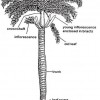 Palms differ greatly from broadleaf (dicot) and coniferous (Gymnosperm) trees in their overall form and external structure (morphology) and in their internal structure (anatomy). Morphology and anatomy determine how palms grow, function, and respond to external and internal stress factors. This publication provides a basic understanding of how palms are constructed. This 4-page fact sheet was written by T. K. Broschat, and published by the UF Department of Environmental Horticulture, May2013.
Palms differ greatly from broadleaf (dicot) and coniferous (Gymnosperm) trees in their overall form and external structure (morphology) and in their internal structure (anatomy). Morphology and anatomy determine how palms grow, function, and respond to external and internal stress factors. This publication provides a basic understanding of how palms are constructed. This 4-page fact sheet was written by T. K. Broschat, and published by the UF Department of Environmental Horticulture, May2013.
http://edis.ifas.ufl.edu/ep473
Alternatives to Invasive Plants Commonly Found in North Florida Landscapes (ENH1206/EP467)
 Based on years of UF/IFAS research producing and trialing cultivars, this 3-page fact sheet lists native and non-invasive, non-native ornamentals as alternatives to invasive plants commonly used in Florida landscapes. Only plants considered to be generally available in the nursery trade are listed. Alternative plants are similar to respective invasive plants as much as possible in terms of size, habit, texture, and flower color.was written by Gary W. Knox, Sandra B. Wilson, Zhanao Deng, and Rosanna Freyre, and published by the UF Department of Environmental Horticulture, August 2013.
Based on years of UF/IFAS research producing and trialing cultivars, this 3-page fact sheet lists native and non-invasive, non-native ornamentals as alternatives to invasive plants commonly used in Florida landscapes. Only plants considered to be generally available in the nursery trade are listed. Alternative plants are similar to respective invasive plants as much as possible in terms of size, habit, texture, and flower color.was written by Gary W. Knox, Sandra B. Wilson, Zhanao Deng, and Rosanna Freyre, and published by the UF Department of Environmental Horticulture, August 2013.
http://edis.ifas.ufl.edu/ep467
Watering Your Florida Lawn (ENH9/LH025)
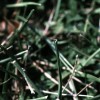 Irrigation is one of the most important cultural practices that we do for our lawns. Since water is a limited resource and is vital to the health of your lawn, it is very important that watering be done correctly. This 3-page fact sheet was written by L. E. Trenholm, J. B. Unruh, and J. L. Cisar, and published by the UF Department of Environmental Horticulture, April 2013.
Irrigation is one of the most important cultural practices that we do for our lawns. Since water is a limited resource and is vital to the health of your lawn, it is very important that watering be done correctly. This 3-page fact sheet was written by L. E. Trenholm, J. B. Unruh, and J. L. Cisar, and published by the UF Department of Environmental Horticulture, April 2013.
http://edis.ifas.ufl.edu/lh025
Florida-Friendly Plants for Stormwater Pond Shorelines (ENH1215/EP476)
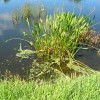 Selecting aquatic and shoreline plants for stormwater ponds is more challenging than selecting plants for a typical landscape. Site conditions can vary greatly and are more difficult to control. For example, water depth sometimes fluctuates widely, creating wet and dry conditions. Water quality varies with rainfall and fertilizer inputs. Steep slopes can make plant establishment and retention difficult. The concept of using the right plant in the right place is particularly important in the shoreline environment because the planting area includes a dry slope and a littoral shelf with shallow and deep water areas. This 4-page fact sheet recommends plants that were selected based on these three questions: 1) What environmental conditions does the plant need to grow? 2) How do you want the plant to function? 3) What do you want the plant to look like? Written by Gail Hansen and Shangchun Hu, and published by the UF Department of Environmental Horticulture, May 2013.
Selecting aquatic and shoreline plants for stormwater ponds is more challenging than selecting plants for a typical landscape. Site conditions can vary greatly and are more difficult to control. For example, water depth sometimes fluctuates widely, creating wet and dry conditions. Water quality varies with rainfall and fertilizer inputs. Steep slopes can make plant establishment and retention difficult. The concept of using the right plant in the right place is particularly important in the shoreline environment because the planting area includes a dry slope and a littoral shelf with shallow and deep water areas. This 4-page fact sheet recommends plants that were selected based on these three questions: 1) What environmental conditions does the plant need to grow? 2) How do you want the plant to function? 3) What do you want the plant to look like? Written by Gail Hansen and Shangchun Hu, and published by the UF Department of Environmental Horticulture, May 2013.
http://edis.ifas.ufl.edu/ep476
Field Production of Palms (ENH1210/EP471)
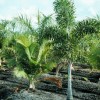 Field production is the most practical means of producing large palm specimens, and it has several advantages over container production. Yield per acre can be maximized compared to many other woody ornamentals because of the columnar growth habit of most palms and their ability to survive transplanting with a minimal root ball. When dug and tied properly, many more palms can be loaded into a standard shipping container than could similarly sized trees. Palms also offer great versatility in the method of field harvesting.This 7-page fact sheet was written by Timothy K. Broschat, Alan W. Meerow, and Jack Miller, and published by the UF Department of Environmental Horticulture, April 2013.
Field production is the most practical means of producing large palm specimens, and it has several advantages over container production. Yield per acre can be maximized compared to many other woody ornamentals because of the columnar growth habit of most palms and their ability to survive transplanting with a minimal root ball. When dug and tied properly, many more palms can be loaded into a standard shipping container than could similarly sized trees. Palms also offer great versatility in the method of field harvesting.This 7-page fact sheet was written by Timothy K. Broschat, Alan W. Meerow, and Jack Miller, and published by the UF Department of Environmental Horticulture, April 2013.
http://edis.ifas.ufl.edu/ep471
Landscape Design with Edibles (ENH1214/EP475)
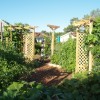 Although design basics for edible ornamental landscapes are essentially the same as strictly ornamental landscapes, a few details ensure the success of the edible landscape. Gardens with plants that change considerably with the seasons rely more on an organized yet interesting layout, appealing support structures, functional pathways, and colorful containers and planters to provide interest and beauty when the plants are not taking center stage. There are twelve important ideas to consider when creating a successful edible ornamental garden. This 4-page fact sheet was written by Gail Hansen, and published by the UF Department of Environmental Horticulture, May 2013.
Although design basics for edible ornamental landscapes are essentially the same as strictly ornamental landscapes, a few details ensure the success of the edible landscape. Gardens with plants that change considerably with the seasons rely more on an organized yet interesting layout, appealing support structures, functional pathways, and colorful containers and planters to provide interest and beauty when the plants are not taking center stage. There are twelve important ideas to consider when creating a successful edible ornamental garden. This 4-page fact sheet was written by Gail Hansen, and published by the UF Department of Environmental Horticulture, May 2013.
http://edis.ifas.ufl.edu/ep475
Gardening in Raised Beds (ENH1211/EP472)
 Gardening in raised beds is becoming more popular as more people try growing their own food. Using raised beds is like growing plants in large containers. The planting area is raised above the existing soil level and usually enclosed within a structure to form a planting bed. This 3-page fact sheet was written by Terry Brite DelValle, and published by the UF Department of Environmental Horticulture, May 2013.
Gardening in raised beds is becoming more popular as more people try growing their own food. Using raised beds is like growing plants in large containers. The planting area is raised above the existing soil level and usually enclosed within a structure to form a planting bed. This 3-page fact sheet was written by Terry Brite DelValle, and published by the UF Department of Environmental Horticulture, May 2013.
http://edis.ifas.ufl.edu/ep472
Florida Foliage House Plant Care: Adenium obesum (ENH1213/EP474)
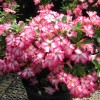 Adenium obesum and its many hybrids are often seen in retail garden centers. They have vibrant floral displays in shades of red, white, pink, and yellow. Flowers average 2–3 inches in diameter and may be single, double, or even triple. The plants must be stationed in high light, 6 hours or more per day, to maintain flowering during the summer. Adenium obesum makes a dramatic specimen for a deck or patio but should be moved indoors in winter. This 2-page fact sheet was written by R. J. Henny and J. Chen, and published by the UF Department of Environmental Horticulture, May 2013.
Adenium obesum and its many hybrids are often seen in retail garden centers. They have vibrant floral displays in shades of red, white, pink, and yellow. Flowers average 2–3 inches in diameter and may be single, double, or even triple. The plants must be stationed in high light, 6 hours or more per day, to maintain flowering during the summer. Adenium obesum makes a dramatic specimen for a deck or patio but should be moved indoors in winter. This 2-page fact sheet was written by R. J. Henny and J. Chen, and published by the UF Department of Environmental Horticulture, May 2013.
http://edis.ifas.ufl.edu/ep474
Nursery Irrigation System Checklist (ENH1208/EP469)
 Irrigation must be intensively managed to achieve optimal production times for plants of superior quality. There must be a balance between excessive and inadequate irrigation. Producers use irrigation control devices and past experience to achieve the balance. A few simple checks before and during irrigation can make a big difference in efficient and uniform delivery of the appropriate amount of water. This 4-page fact sheet was written by Tom Yeager, and published by the UF Department of Environmental Horticulture, April 2013.
Irrigation must be intensively managed to achieve optimal production times for plants of superior quality. There must be a balance between excessive and inadequate irrigation. Producers use irrigation control devices and past experience to achieve the balance. A few simple checks before and during irrigation can make a big difference in efficient and uniform delivery of the appropriate amount of water. This 4-page fact sheet was written by Tom Yeager, and published by the UF Department of Environmental Horticulture, April 2013.
http://edis.ifas.ufl.edu/ep469
Urban Turf Fertilizer Rule for Home Lawn Fertilization (ENH1089/EP353)
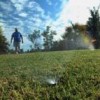 While a healthy lawn typically takes up and uses applied fertilizer for growth and protein production, nutrients may leach or run off into water bodies or groundwater when fertilizer is overapplied or applied to an unhealthy lawn. In an attempt to reduce this nonpoint source pollution, FDACS developed a rule to regulate the amount of N and P applied to lawns as fertilizer. The Urban Turf Fertilizer Rule regulates what can be sold and marketed as an urban turf fertilizer and requires specific wording on the fertilizer bag. This rule was enacted in response to concerns over potential pollution of water resources resulting from the nitrogen (N) and phosphorus (P) in these fertilizers. This 3-page fact sheet was written by Laurie E. Trenholm, and published by the UF Department of Environmental Horticulture, March 2013.
While a healthy lawn typically takes up and uses applied fertilizer for growth and protein production, nutrients may leach or run off into water bodies or groundwater when fertilizer is overapplied or applied to an unhealthy lawn. In an attempt to reduce this nonpoint source pollution, FDACS developed a rule to regulate the amount of N and P applied to lawns as fertilizer. The Urban Turf Fertilizer Rule regulates what can be sold and marketed as an urban turf fertilizer and requires specific wording on the fertilizer bag. This rule was enacted in response to concerns over potential pollution of water resources resulting from the nitrogen (N) and phosphorus (P) in these fertilizers. This 3-page fact sheet was written by Laurie E. Trenholm, and published by the UF Department of Environmental Horticulture, March 2013.
http://edis.ifas.ufl.edu/ep353